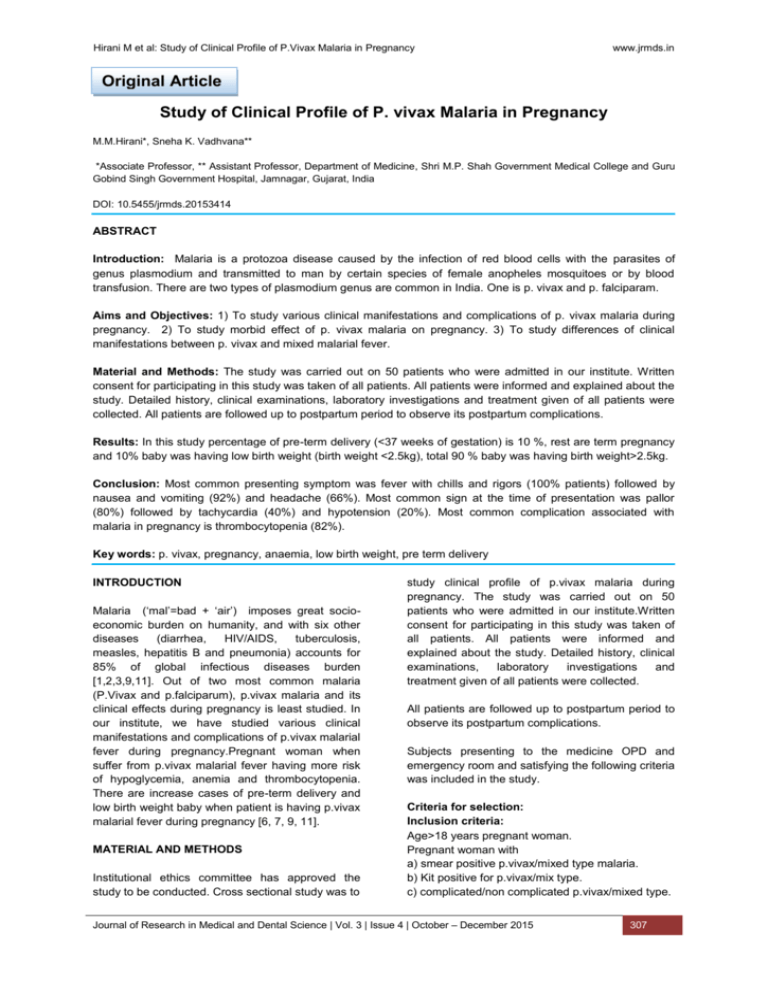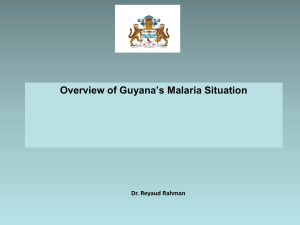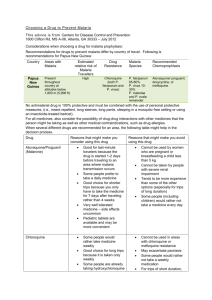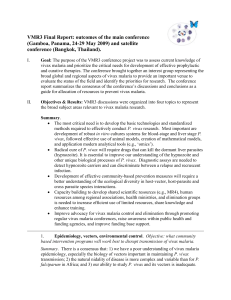Original Article Study of Clinical Profile of P. vivax
advertisement

Hirani M et al: Study of Clinical Profile of P.Vivax Malaria in Pregnancy www.jrmds.in Original Article Study of Clinical Profile of P. vivax Malaria in Pregnancy M.M.Hirani*, Sneha K. Vadhvana** *Associate Professor, ** Assistant Professor, Department of Medicine, Shri M.P. Shah Government Medical College and Guru Gobind Singh Government Hospital, Jamnagar, Gujarat, India DOI: 10.5455/jrmds.20153414 ABSTRACT Introduction: Malaria is a protozoa disease caused by the infection of red blood cells with the parasites of genus plasmodium and transmitted to man by certain species of female anopheles mosquitoes or by blood transfusion. There are two types of plasmodium genus are common in India. One is p. vivax and p. falciparam. Aims and Objectives: 1) To study various clinical manifestations and complications of p. vivax malaria during pregnancy. 2) To study morbid effect of p. vivax malaria on pregnancy. 3) To study differences of clinical manifestations between p. vivax and mixed malarial fever. Material and Methods: The study was carried out on 50 patients who were admitted in our institute. Written consent for participating in this study was taken of all patients. All patients were informed and explained about the study. Detailed history, clinical examinations, laboratory investigations and treatment given of all patients were collected. All patients are followed up to postpartum period to observe its postpartum complications. Results: In this study percentage of pre-term delivery (<37 weeks of gestation) is 10 %, rest are term pregnancy and 10% baby was having low birth weight (birth weight <2.5kg), total 90 % baby was having birth weight>2.5kg. Conclusion: Most common presenting symptom was fever with chills and rigors (100% patients) followed by nausea and vomiting (92%) and headache (66%). Most common sign at the time of presentation was pallor (80%) followed by tachycardia (40%) and hypotension (20%). Most common complication associated with malaria in pregnancy is thrombocytopenia (82%). Key words: p. vivax, pregnancy, anaemia, low birth weight, pre term delivery INTRODUCTION Malaria (‘mal’=bad + ‘air’) imposes great socioeconomic burden on humanity, and with six other diseases (diarrhea, HIV/AIDS, tuberculosis, measles, hepatitis B and pneumonia) accounts for 85% of global infectious diseases burden [1,2,3,9,11]. Out of two most common malaria (P.Vivax and p.falciparum), p.vivax malaria and its clinical effects during pregnancy is least studied. In our institute, we have studied various clinical manifestations and complications of p.vivax malarial fever during pregnancy.Pregnant woman when suffer from p.vivax malarial fever having more risk of hypoglycemia, anemia and thrombocytopenia. There are increase cases of pre-term delivery and low birth weight baby when patient is having p.vivax malarial fever during pregnancy [6, 7, 9, 11]. MATERIAL AND METHODS Institutional ethics committee has approved the study to be conducted. Cross sectional study was to study clinical profile of p.vivax malaria during pregnancy. The study was carried out on 50 patients who were admitted in our institute.Written consent for participating in this study was taken of all patients. All patients were informed and explained about the study. Detailed history, clinical examinations, laboratory investigations and treatment given of all patients were collected. All patients are followed up to postpartum period to observe its postpartum complications. Subjects presenting to the medicine OPD and emergency room and satisfying the following criteria was included in the study. Criteria for selection: Inclusion criteria: Age>18 years pregnant woman. Pregnant woman with a) smear positive p.vivax/mixed type malaria. b) Kit positive for p.vivax/mix type. c) complicated/non complicated p.vivax/mixed type. Journal of Research in Medical and Dental Science | Vol. 3 | Issue 4 | October – December 2015 307 Hirani M et al: Study of Clinical Profile of P.Vivax Malaria in Pregnancy Exclusion criteria: Pregnant women a) negative smear for p.vivax malaria. b) Kit negative malarial fever c) negative smear examination with thrombocytopenia. d) Smear positive from p.falciparam malaria. All the patients satisfying above criteria, given informed consent and admitted as in patients were included in the study. RESULTS In our study, patients are divided into two group 1) group A and 2) group B. Group A patient is having p.vivax malaria 78%. And group B patient is having mixed malaria 22%. Table 1: Symptoms at presentations Group Group Symptoms Total A B Fever with chills 39 11 50 and rigors Nausea and 25 21 46 vomiting % 100 92 headache 20 13 33 66 Severe weakness 12 14 26 52 Breathlessness 0 0 0 0 Convulsion 0 1 1 2 Altered sensorium 0 1 1 2 0 0 0 0 0 0 0 0 0 0 0 0 Abnormal bleeding Abdominal pain/anorexia Decreased urine output Graph 1: Signs at presentation www.jrmds.in It is observed from the table-1 that all patients included in the study had fever with chills and rigors (100%) at the time of presentation [1, 2, 3, 9, 11]. The next common symptom was nausea and vomiting (92%) followed by headache (66%), severe weakness (52%). Convulsions (2%) and altered sensorium (2%) were seen in patients with cerebral malaria. None of the patient is having breathlessness, ARDS, bleeding tendency. In our study most common sign at the time of presentation was pallor (80%) followed by tachycardia (40%) and hypotension (20%). Icterus (4%) and hepatomegaly (4%) are seen in patients with malaria associated with hepatopathy Petechias and or ecchymosis were not seen in patients In spite of thrombocytopenia [9, 11]. Table 2: Complications associated with malaria Group Group Complications Total % A B thrombocytopenia 31 10 41 82 anaemia 34 6 40 80 Hypoglycaemia 7 3 10 20 Hepatopathy 2 0 2 04 Severe hypotension 1 0 1 02 Cerebral malaria 0 1 1 02 0 1 1 02 0 0 0 00 Pancytopenia 0 0 0 00 nephropathy 0 0 0 00 Malarial ARDS 0 0 0 00 Severe prostration with collapse Bleeding coagulopathy In our study 40% patients presented with malaria associated with thrombocytopenia but they were no symptoms of abnormal bleeding like hematuria, melena and signs like petechias and ecchymosis. Hypoglycaemia: in our study 20% patients are having hypoglycaemia (random blood sugar < 70mg %). Hepatopathy: in our study 4% patients are having hepatopathy in form of raised SGPT and bilirubin.Severe prostration:In our study around 2% patients were present with severe weakness and prostration and associated with one or two attacks of collapse.Cerebral malaria:In our study around 2% patients were present with cerebral malaria. They were present with convulsions and or altered behaviour. Anaemia: In our study 16% patients were present with severe anemia (Hb level < 8 mg/dl), mainly normocytic normochromic anaemia [4, 5, 6, 7, 9]. 308 Journal of Research in Medical and Dental Science | Vol. 3 | Issue 4 | October – December 2015 Hirani M et al: Study of Clinical Profile of P.Vivax Malaria in Pregnancy Graph 2: PRE TERM DELIVERY No. of patients 40 35 www.jrmds.in pregnancy is associated with increased risk of low birth weight and pre term pregnancy [9, 11]. 35 30 25 20 15 10 10 TERM 4 5 PRE TERM 1 0 GROUP A GROUP B Groups In our study percentage of pre-term delivery (<37 weeks of gestation) is 10 %. Graph 3: BIRTH WEIGHT 40 35 No. patients 35 30 25 20 LOW<2.5 kg 15 10 5 10 4 1 NORMAL>2.5 kg 0 GROUP A GROUP B Groups In our study, 10% baby having low birth weight (birth weight <2.5kg). DISCUSSION The study was conducted on 50 hospitalized patients of aged more than 18 years and presenting with smear and kit positive p.vivax malarial fever with pregnancy. P vivax malaria can have deleterious effects on the health of the mother and the neonate. More accurate data of vivax malaria during gestation are essential to improve its clinical management and to guide control policies. Pre term delivery and low birth weight: In our study, women having pre term delivery (1%) gave birth to low birth weight baby. This finding is supported by study done in Bolivia. According to study, guayamerin and Bermejo, Bolivia, 2002-2004 mean birth weight was lower in premature babies and baby born to anemic mothers and to mothers infected with p.vivax during pregnancy.so, preterm delivery and p.vivax infection during pregnancy were associated with low birth weight. Our finding is also supported by study done in Brazilian-amazon (desai et al 2007) malaria and Anaemia: Anaemia is defined as a state in which the blood haemoglobin level is below the normal range for the patient’s age and sex.Malaria with severe anaemia presents with symptoms like weakness, fatigue, breathlessness, lethargy, episodes of collapse etc. and signs like pallor, tachycardia, tachypnoea etc. Normal adult haemoglobin level for female is 11.5-15g/dl. In our study, 80% patient is having anaemia (80%).out of them 8 (16%) patients are having severe anaemia. This finding is comparable with Singh et al 2005 study, stated that 90% pregnant mother with p.vivax malaria is anaemic. According to study high proportion of pregnant women in study sites in Bolivia had anaemia and proportion of anaemia increased with parity. As observed in unstable malaria transmission settings, the risk of maternal anaemia was more pronounced in multipara women. In our study, p.vivax infection is associated with a reduction of haemoglobin less than 7 mg/dl. A similar finding observed in Honduras (5) study in p.vivax infected pregnant women. In our study, risk of maternal anaemia is more in multipara pregnant mother. 90% cases of multipara patient are having anaemia. This finding is comparable with study done in northen Bolivia stated that risk of maternal anaemia was associate with multiparty and delivery. In our study p.vivax infection acquired during pregnancy remained independently associated with the risk for moderate to severe anaemia. A similar relationship was observed in Thailand study. Anaemia results from accelerated RBC removal by the spleen, RBC destruction at parasite schizogony and ineffective erythropoiesis. In severe malaria, both infected and uninfected RBCs show reduced deformability which correlates with prognosis and development of anaemia. Splenic clearance of all RBCs is increased in malaria. There is some role of immune complex depositions in the pathogenesis of severe anaemia.Hemoglobin levels inversely correlate with immune complex level in severe anaemia [9, 11]. Hepatopathy: It is defined as smear positive malaria associated with raised s.bilirubin and SGPT.In our study only one patient is having malarial hepatopathy. So only 2% patient of p.vivax with pregnancy is having hepatopathy.Mild haemolytic jaundice is common in malaria. Severe jaundice is associated with P.falciparam infections and more common among adults than children. It mainly results from haemolysis, hepatocyte injury and cholestasis. When accompanied by other vitalorgan dysfunction it carries a poor prognosis. Hepatic dysfunction contributes to hypoglycaemia, Journal of Research in Medical and Dental Science | Vol. 3 | Issue 4 | October – December 2015 309 Hirani M et al: Study of Clinical Profile of P.Vivax Malaria in Pregnancy lactic acidosis and impaired drug metabolism. Occasional patients with falciparum malaria may develop deep jaundice (with haemolytic, hepatic, and cholestatic components) without evidence of other organ dysfunction [9, 11]. Hypoglycemia: in our study 10 patients are having hypoglycaemia (random blood sugar =<70mg %). This is due to either p.vivax malaria or hepatopathy or chloroquine induced. This means p.vivax malaria with pregnancy is associated with hypoglycaemia.20% patients are having random blood sugar<70mg% [9, 11]. Cerebral malaria: Cerebral malaria is defined as Failure to localize or respond to appropriately noxious stimuli; coma persisting for >30 min after generalized convulsion. Sometimes malaria also associated with convulsions which is defined as more than two generalized seizures in 24 h; signs of continued seizure activity sometimes subtle (e.g. tonic-clonic eye movements without limb or face movement)[9].In our study only one (1%) patient is having cerebral malaria that responded to quinine well and cured. Cerebral malaria manifests as diffuse symmetric encephalopathy. Focal neurologic signs are very unusual. Signs of meningeal irritation are absent. The corneal reflexes are preserved except in deep coma. Reflexes are variable. Many patients are associated with retinal haemorrhages and pupillary dilatation. Convulsions, usually generalized and often repeated, occur in 10% of adults and up to 50% of children with cerebral malaria. Coma is a characteristic and ominous feature of falciparum malaria and despite treatment it is associated with death rates of 20% among adults and 15% among children. There is high level of immune complexes in the patients of cerebral malaria. By cross linking Fc receptors on macrophages, immune complexes can stimulate the production of proinflammatory cytokines. These elevated levels of cytokines have a role in pathogenesis of cerebral malaria. Thrombocytopenia: Thrombocytopenia with or without bleeding coagulopathy is defined as decreased platelets count (<50,000/µL of blood). Coagulopathy is defined as prolonged Prothrombin Time (PT), prolonged Activated Partial Thromboplastin Time (APTT) and decreased fibrinogen level (<200mg/dL). Patients present with symptoms of abnormal bleeding from abnormal sites like hematuria, hematemesis, melena etc. and various signs like petechias, ecchymosis etc. In our study 82% patient is having thrombocytopenia which is asymptomatic [4, 5, 7, 9]. 310 www.jrmds.in Malarial ARDS: Patients with malarial ARDS present with non-cardiogenic pulmonary edema. It occurs due to release of inflammatory cytokines and these cytokines act upon lung parenchyma to produce generalized parenchymal inflammation. Patients of malarial ARDS present with severe breathlessness, tachycardia, tachypnoea, low oxygen saturation.In our study none patient is having malarial ARDS [9, 11]. Nephropathy: Malarial nephropathy is defined as urine output <400 mL/day in adults or <12 mL/kg in children with no improvement with rehydration and serum creatinine level of>265 mol/L (>3 mg/dL) [4, 5, 6, 7, 9]. In our study none patient is having nephropathy. Slide positivity rate: In our study total 50 patients are tested for peripheral smear for malarial parasite.out of them 30(60%) patients are smear positive and 20 patients are kit positive. This finding is comparable with finding seen in study of Singh et al 2005 in which slide positivity rate is 58% [1, 2, 3, 11]. Treatment Outcomes: In our study all pregnant women in first trimester and uncomplicated is given chloroquine for 3 days course as per national malarial guideline. Pregnant women in second and third trimester are given artesunate 3 days course as per national malarial guideline. One patient who is having cerebral malaria is given quinine 7 days as per national antimalarial guideline. Our all patients are cured 100% with treatment given according to national antimalarial guidelines without treatment failure, or drug adverse reaction [9, 10, 11]. CONCLUSION Most common presenting symptom was fever with chills and rigors (100% patients) followed by nausea and vomiting (92%) and headache (66%). Most common sign at the time of presentation was pallor (80%) followed by tachycardia (40%) and hypotension (20%).Most common complication associated with malaria in pregnancy is thrombocytopenia (82%) followed by anaemia (80%)(8 patients are having severe anaemia). 38(76%) patients were having smear positive malaria and 12(24%) patients are having kit positive malarial fever.10% patients are having pre term delivery and low birth weight baby. For treatment in first trimester chloroquine was used and was cured without any complications. One patient having cerebral malaria was treated with Journal of Research in Medical and Dental Science | Vol. 3 | Issue 4 | October – December 2015 Hirani M et al: Study of Clinical Profile of P.Vivax Malaria in Pregnancy quinine for 7 days and she responded well and cured. REFERENCES 1. 2. 3. 4. 5. 6. 7. Malaria drug policy 2007, Directorate of National Vector Borne Disease Control Programme, Directorate General of Health Services, Ministry of Health and Family Welfare National drug policy on malaria 2008, Directorate of National Vector Borne Disease Control Programme, Directorate General of Health Services, Ministry of Health and Family Welfare National drug policy on malaria 2010, Directorate of National Vector Borne Disease Control Programme, Directorate General of Health Services, Ministry of Health and Family Welfare Sarkar S, Bhattacharya P. Cerebral malaria caused by Plasmodium vivax in adult subjects. Indian J Crit Care Med 2008;12(4):204-5. Thapa R, Patra V, Kundu R. Plasmodium vivax cerebral malaria. Indian Pediatric 2007; 44(6):433-4. Kochar DK, Das A, Kochar SK, Saxena V, Sirohi P, Garg S et al. Severe Plasmodium vivax Malaria: A Report on Serial Cases from Bikaner in North western India. Am. J. Trop. Med. Hyg 2009; 80(2):194-8. Lacerda MV, Murao MP, Alexandre MA, Siqueira AM, Magalhaes BM, Brasil P et al. Understanding the clinical spectrum of complicated Plasmodium vivax malaria: A systemic review on the contributions of the Brazilian literature. Malar J. 2012;11:12. www.jrmds.in 8. The History of Malaria, an Ancient Disease. [Internet] 2012. [Cited on 19 June 2012]Available from: http://www.cdc.gov/malaria/about/history/ 9. White NJ, Bremen JG. Malaria In:Fauci AS, Kasper DL, Hauser SL, Longo DL, Jameson JL, Loscalzo et al., editors. Harrison’s principles of internal medicine. 18th ed. New York: McGraw Hill 2012. p 1688-1705. 10. Guidelines for diagnosis and treatment of malaria in India 2011. National Institute of Malaria Research. National Vector Borne Disease Control Programme. 11. K. Park, author. Parks Textbook of Preventive & Social Medicine. 21st ed. Banarasidas Bhanot 2011. 12. Estimation of malaria disease burden in India. Report of an Informal Consultative Meeting, New Delhi, India, 21-23 November 2007. Corresponding Author: Dr. Sneha K. Vadhvana Quarter number C 27, Medical campus, Jamnagar, Gujarat, India Email: svadhvana@yahoo.com Date of Submission: 18/04/2015 Date of Acceptance: 12/06/2015 How to cite this article: Hirani MM, Vadhvana SK. Study of Clinical Profile of P.Vivax Malaria during Pregnancy. J Res Med Den Sci 2015;3(4):307-11. Source of Support: None Conflict of Interest: None declared Journal of Research in Medical and Dental Science | Vol. 3 | Issue 4 | October – December 2015 311








